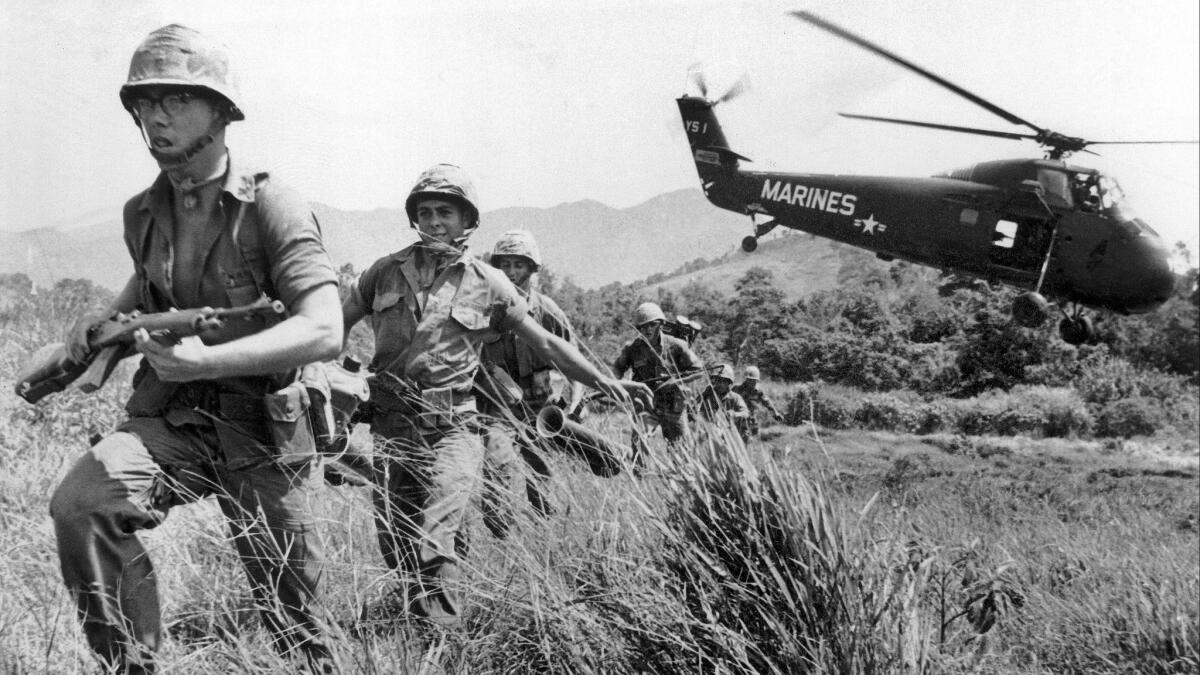Op-Ed: How the U.S. ‘Goliath’ can win against its ‘David’ adversaries

- Share via
Fifty years ago, the stunning Tet Offensive shattered the American war effort in Vietnam. But its impact wasn’t limited to Vietnam — it created a shadow that has darkened American military strategy ever since.
On Jan. 31, 1968, 84,000 North Vietnamese troops attacked 100 cities across U.S.-backed South Vietnam, including the key targets of Hue, Da Nang and Saigon. They aimed to spark a widespread uprising, which didn’t happen.
Instead, North Vietnam stumbled into a costly war-winning strategy. Costly because more than half its attacking forces were killed, wounded or captured. Winning because the carnage forced Americans to confront the reality of the war: a savage, endless conflict that contradicted official talking points.
The U.S. commander, Army Gen. William Westmoreland, famously focused on enemy body counts in a strategy designed to kill North Vietnamese troops “at a rate as high as their capacity to put men into the field.” Just before Tet, Westmoreland was “absolutely certain” the U.S. was winning. After Tet, he called it “a striking military defeat for the enemy.”
The media was skeptical. On Feb. 8, the New York Times opined “neither side can win.” And on Feb. 27, CBS News anchor Walter Cronkite, back in the U.S. after a reporting trip to Vietnam, delivered a commentary to more than 20 million viewers: “We are mired in stalemate,” he said. “The only rational way out … will be to negotiate, not as victors ….” American public support soon withered. President Nixon replaced President Lyndon Johnson. Eventually, the United States withdrew from South Vietnam, which subsequently fell to the North in 1975.
Tet validated a Japanese concept. Toward the end of World War II, when the American military was dominant, Hiromichi Yahara, a Japanese army colonel serving on the island of Okinawa, forged a strategy to win against such military superiority. Yahara saw that direct assaults against overwhelming American forces wouldn’t work. Instead, he aimed to punish his adversary through attrition, to inflict a terrible price on the enemy no matter the cost to his own soldiers. His plan was guided by this precept: “If a poor man fights with the same tactics as a rich man, he is sure to lose.”
Yahara used intense bunker- and cave-fighting to bleed America’s will to fight. It yielded painful results: The battle for Okinawa in 1945 resulted in hundreds of thousands of casualties and helped dissuade the U.S. from invading and occupying Japan. Still, the war too far gone, Japan would surrender — the last time a nation formally surrendered to the American military.
“Davids” have won a majority of wars against “Goliaths” since 1945.
What didn’t work for Japan succeeded in Vietnam after Tet. And since then, weaker adversaries have adopted strategies with common features against stronger forces. Don’t try to win; make your opponent lose. Attack will; not strength. Leverage chaos; inflict pain for gain. Bring down the pillars of power, even if it costs you everything.
“Davids” have won a majority of wars against “Goliaths” since 1945. A 2010 Rand Corp. study found that of 30 insurgencies around the globe since 1978, only eight were clear victories for the governments over the rebels.
The American “Goliath” has also fared poorly. In 1993, warlord Mohamed Farah Aidid bloodied the U.S., turning public opinion against American involvement in Somalia; U.S. forces withdrew. Osama bin Laden saw what had happened and devised a plan, as he described it in 2004, “to cause America to suffer human, economic and political losses.” The 9/11 attack cost Al Qaeda $500,000; it ultimately forced America to spend nearly $5 trillion in its long-term response. Initial victories in Afghanistan and Iraq have settled into slogs and become the longest wars in American history.
Even the successful Gulf War is a rule-proving exception. When the U.S. fights in open deserts against uniformed soldiers, precise firepower works and America tends to win. But that’s not where this nation’s toughest enemies choose to fight.
Our sharpest adversaries, following Yahara’s precept and Tet’s example, prefer to fight in cities like Kabul, which Afghan President Ashraf Ghani now describes as “under siege.” Our enemies confront us in densely populated urban areas because they know these features negate American technological advantages, particularly air strikes.
So how does Goliath win against such enemies?
Despite the fact that a few stubborn military officers still believe we can just kill enough of the enemy to win, there’s a better way. Going forward, America’s best strategy is smart attrition warfare: Use multiple, precise military means to remove the bad guys from the field, including traditional strikes, but combine that with non-lethal approaches such as co-option, alliance-building and other inducements to support local good guys and generate gains.
We shouldn’t kid ourselves that war will ever be bloodless, but we must also recognize that strategic success has never been strictly limited to killing the enemy. And it never will be.
When the Gulf War ended, President George H.W. Bush claimed America had “kicked the Vietnam syndrome once and for all!” That statement was premature. Hopefully, with smarter military strategies, we finally will.
Army Maj. ML Cavanaugh is a nonresident fellow with the Modern War Institute at West Point and co-edited the forthcoming book, with Max Brooks, “Strategy Strikes Back: How Star Wars Explains Modern Military Conflict.” Twitter: @mlcavanaugh.
Follow the Opinion section on Twitter @latimesopinion and Facebook
More to Read
A cure for the common opinion
Get thought-provoking perspectives with our weekly newsletter.
You may occasionally receive promotional content from the Los Angeles Times.









